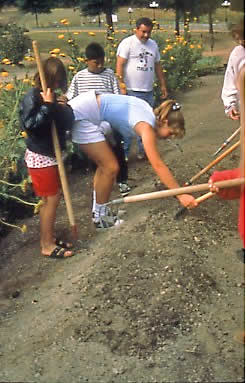Using the mounding technique is a relatively easy solution. Mounded beds are frequently used for specialty gardens such as succulents, sunflowers, California natives, or plantings to attract butterflies, etc. A simple mounded bed can be 4 to 6 inches high with a level top and with no support along the outside edges. Mounded beds require more maintenance than enclosed beds and they lose shape when little feet cut corners or hurdle plantings.

Preparing the Soil
Working the soil when it is too wet can seriously damage it. If the soil seems very dry and hard, water the area deeply then wait 2 to 4 days before digging. If the soil sticks to your tools, wait a few days for it to dry more, and check the moisture again. Soil is best worked when it crumbles in your hands.
To get a mounded bed ready for planting:
-
- Use a digging fork to loosen the soil. Slide the fork under the soil and lift without turning. Fork up the soil to loosen.
- Work the soil thoroughly to a depth of 12 to 18 inches.
- Evenly spread, and till in compost, organic matter, pre-plant fertilizer and, if needed, gypsum or other soil amendments when recommended from your soil analysis report. NOTE: More detail is included in the next section – Enriching the Soil, subtopic Amendments, Fertilizer, and Soil pH.
- Be sure to select a calm day when applying amendments because a strong breeze may create a breathing hazard and can carry some away.
- Use a shovel or rake to move soil from the pathway to the top of the bed. Add enough soil to hill the beds to a height of 4 to 6 inches.
- Soak the bed before planting, as soil will settle to 2 to 3 inches. From this point on, walk only in the pathways, not on the marked beds.
Finish and Shape
To complete a freshly dug bed:
-
- Break up any chunks of earth with a garden fork or hoe.
- Level the top of the bed with the back of the rake.
- Remove any large rocks and debris.
- The edges of the bed should slope downward at a 45° angle. Creating a lip of soil around the top edge of a new bed will help reduce erosion.
Because a freshly built mounded bed is loose and full of air, it settles initially and can easily erode. Four to six inches is usually all the height you can expect. Add more soil, organic matter or compost if the bed loses height. Then top with a layer of mulch to help control weeds and retain water.
Array